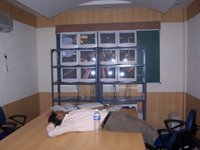I got my 4th job offer on 16th. This time it's Google, Hyderabad. This concludes the Google honeymoon which started on Dec 6th last year and lasted for 101 days. The process involved 9 interviews (2 on phone, 5 in Bangalore and 2 in Hyderabad), numerous mails and a similar no of phone calls, and fetched me my first air-trip (to and fro Bangalore in Jet airways) and 2 Google T-shirts.
Interview 1 - Interview 8:
Algorithms algorithms algorithms algorithms.
Each interview involved 2-3 questions and would last for about 1 hr.
Interview 9:
It can't really be called an interview. The only question I was asked was the meaning of my name, which, for natural reasons, wasn't very difficult to answer. The rest of the time was spent in me asking questions while my interviewer stood near the board explaining me things. He explained me a lot of things related to Google, the policies, the interviewing process, etc. He explained me Google's 80-20 funda, by which a person is given 20% (i.e. 1 day per week) free time to work on anything. This one day gives a person the chance to develop something very useful and interesting. The end-product can be recommended in the review process (which takes place every 6 months) and might lead to promotion and other incentives. Many of Google's flagships product have emerged from this 20% time. Ex: Orkut, Adsense, Google News.
Some excerpts from Interview 9:
Me: This is my 9th interview. What does this mean?
Ans: Nothing. A person is interviewed till as long as the deciding committee feels that the candidate hasn't been tested in all aspects.
Me: Should I expect more interviews?
Ans: Not very likely. 9 interviews is kind of enough for a fresher. I had 13 interviews.
Me: How many people are there at Google, Hyderabad.
Ans: There are 300 people, but only 20 engineers. The rest are people in advertising, marketing, art, design, etc, etc, etc.
Me: What is SDE, SET, SQA, etc.
Ans: These are names given to positions. SDE -- Software Devel Engineer, SET -- Software Engineer in Test, SQA -- Software Quality Assurance. When a person joins Google, he's just assigned to one of these based on some heuristics during the interviewing process. The real allocation is done 6 months later. Google doesn't do the dirty kind of testing.. the ones like black-box testing, monkey testing -- these are outsourced.
In essence, the motive of the interview was to convince me that Hyderabad does exciting technical work contrary to the popular notion associated with the word test. He was successful.
Ringtones Location
16 years ago
